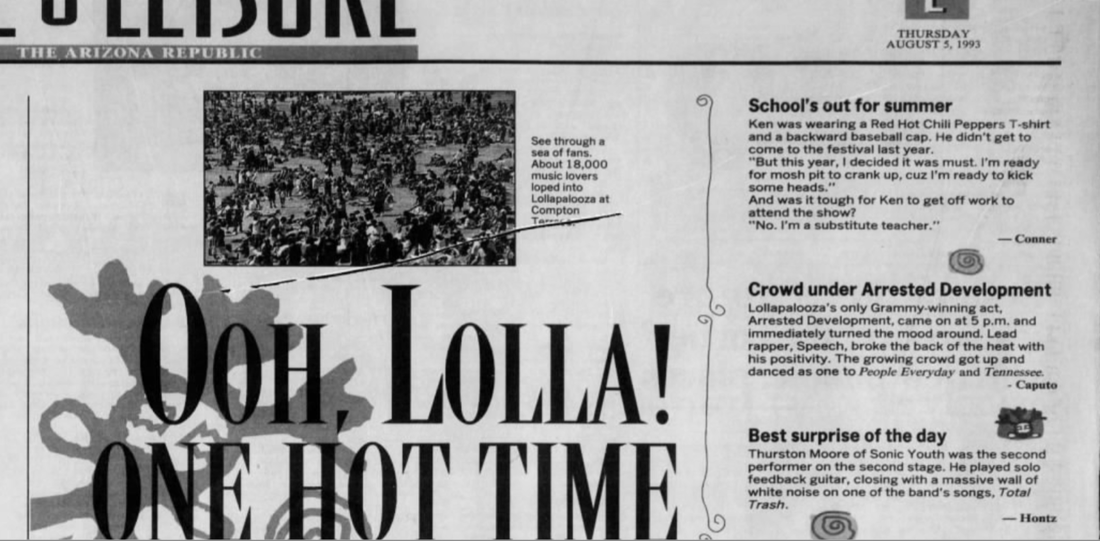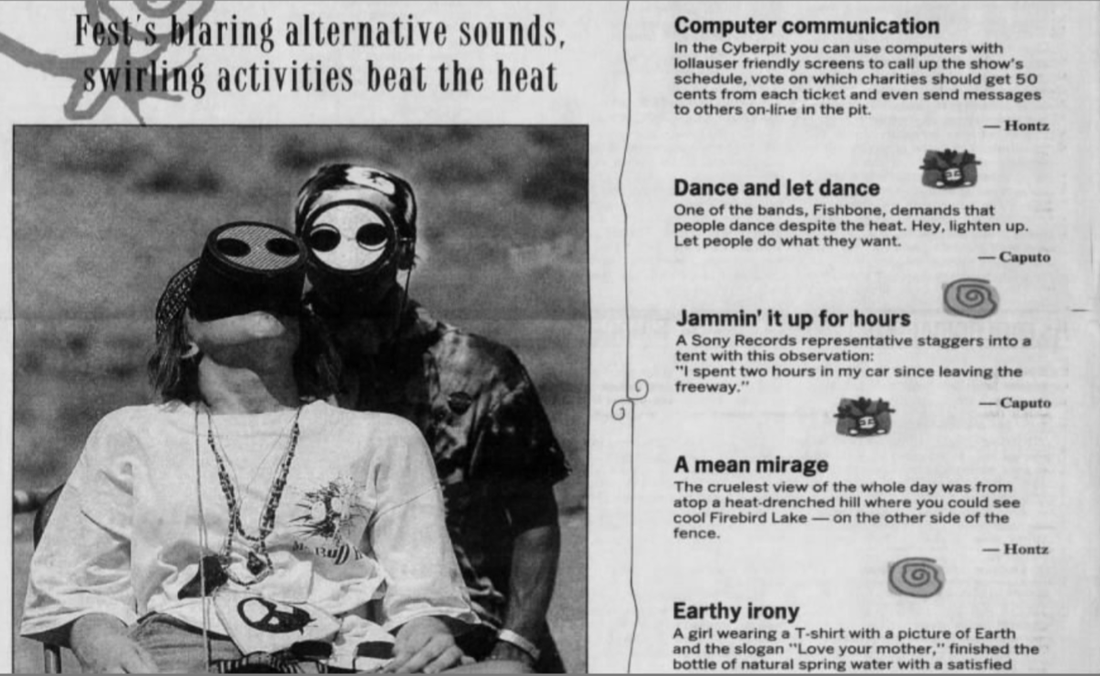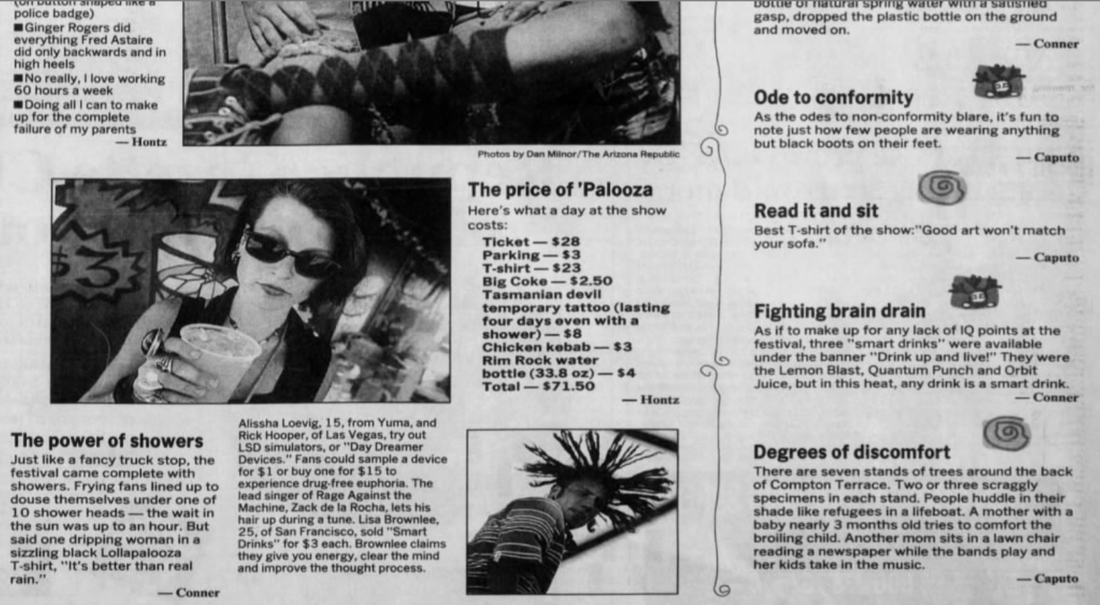|
By Thomas Conner
© Chicago Sun-Times A month ago, Roger Waters was in Chicago rebuilding Pink Floyd's "The Wall." One of the many themes in that show and its 1979 concept album is the barrier between artist and audience. Waters erects that barrier, building a 30-foot, white-brick manifestation of theater's "fourth wall," behind which his band continues to play. On the other side, the audience is left to watch synced animation projected onto the wall. It's true musical theater. The Gorillaz ape a similar theatrical approach. A band of cartoon characters, created a decade ago by Blur singer Damon Albarn and "Tank Girl" creator-illustrator Jamie Hewlett, Gorillaz presents its live music the way the Wizard of Oz presented his edicts: A screen, sometimes a holographic projector, depicts the larger- and loonier-than-life animated players, and we're to pay no attention to that band behind the curtain making the actual music. Like Waters, the whole conceit began as a way to separate sender and receiver to make a statement about the consumption (or not) of music. "It's a very hard point to get across, still," Hewlett said during a recent interview from his London studio. "We live in a time where, for a lot of people, celebrity is everything. We have thousands of huge celebrities who have no talent to offer, but because you see their face all the time you're conned into thinking that they're celebrities. With Gorillaz, we wanted to show that imaginary characters could be bigger than actual celebrities, who are really imaginary characters, anyway. Tough battle that one. We've persevered with it. I think Murdoc [the Gorillaz bassist] is a legitimate rock star — and believable at that, and a funny one and one of my favorites alongside Keith Richards and Tom Waits." Gorillaz emerged from the mist when Hewlett and Albarn shared a flat and began spending evenings making fun of MTV. But it's grown beyond mere snark. "Of course, now I'd like to think that our perspective is much larger than just poking at MTV and the idea of public image," Albarn said in a separate interview. "Now we're to the point where it feels like a comment on popularism itself, our approach to pop music and how it's relative with consumerism. On this record especially, we treat pop culture as a kind of adversary, really. Although it's a loose narrative, and plastic and rubbish is dealt with on a more metaphysical sense, there's something very much worth meditating on with this record. "We ourselves are a part of the pop culture, but it's OK to dissect it and look at it from not necessarily an entirely positive aspect. Which is not something pop culture is terribly comfortable with. I mean, look at pop music, if you can bear to. Find me some social conscience in it." The album he refers to is Gorillaz' third full-length effort, this summer's star-studded "Plastic Beach." The album is a set of more pop-oriented electronic and hip-hop songs, many of which make vague statements about the plasticity of culture or the literal plastic humans consume and discard. It features a range of guests, including Lou Reed, Snoop Dogg, Bobby Womack, Mos Def, Mark E. Smith, De La Soul and more, not to mention Mick Jones and Paul Simonon from the Clash. Womack, Jones and Simonon are on the tour, and others are popping onto some dates as special guests. That's part of the reason the current Gorillaz tour pulls the cartoons back a bit, piercing the veil. With such star power onstage, why hide it? ("I couldn't entertain the idea of putting Lou Reed or Bobby Womack behind a screen," Albarn said. "I'm not that daft.") Hewlett has completed plenty of visuals for the entirety of the concerts, but this time they're on a screen that's up and slightly behind the human band onstage. There's a nautical theme. Jones and Simonon wear sailor suits. The visuals almost became more central to the live shows, though, instead of less. The original plan was to move past the existing 2-D animation and into a concert of 3-D holograms. They tinkered with the technology and got it to work for their joint performance with Madonna opening the Grammys in 2006. Well, it sort of worked. "It looked fantastic on TV, but that's it," Hewlett said. "Live, it's impossible to do, it turns out. You can't turn your bass up, you can't turn anything up, because it vibrates the invisible expensive holo-screen stretched between the band and the audience. The holograms go to pieces. At the Grammys, there was not really any sound in the actual theater. The [technicians] we did that with, since then, have fixed the problem, but it's too nerve-wracking to attempt." "If it were at all possible, we'd be doing it," Albarn said of the holograms. "You just can't do it yet. It belongs to the brave new world, really. ... So the cartoons are back. It's a complete animated narrative above me now. Watching it as we're playing, it feels really strong. I think it's more satisfying, easier for people to watch us and the screen. They're a very strong presence in the ether above us, looking down on us from some kind of digital pantheon." Albarn said "Plastic Beach" began with 80 pieces of music, so he expects Gorillaz to keep lumbering forward. After this tour, though, he's back to working on even grander stage projects. He and Hewlett collaborated on an opera, "Monkey: Journey to the West," which enjoyed an extended run in London, and Albarn currently is at work on another project "with operatic elements" about a 16th century mystic, due next summer. He also reports that he and the other members of Blur are "still in communication and are intending to do something in the new year." GORILLAZ with N.E.R.D. • 7:30 p.m. Saturday • UIC Pavilion, 1150 W. Harrison • Tickets, $49.50-$95; • (800) 745-3000; ticketmaster.com By Thomas Conner
© Chicago Sun-Times Which band in this year’s Lollapalooza lineup has accomplished all of the following? — Sold out a 55,000-seat arena — 18 times. — Created and popularized its own form of glam. — Sold 30 million albums. — Recorded a classical album with Beatles producer George Martin. It ain’t Lady Gaga. The band is X Japan, the biggest rock band in Japanese history. The quintet came together in 1982 (originally called just X, but John Doe had something to say about it), disbanded in 1997 and re-formed in 2007. They started as a speed metal band with delusions of grandeur and evolved into a power-ballad powerhouse. Their shows are equal parts Anthrax and Celine Dion. In their homeland, their presence still creates Beatlesque hysteria, with screaming fans and impenetrable throngs. When the founding guitarist, Hideto “Hide” Matsumoto, died in 1998, nearly 50,000 weeping mourners crowded the funeral; last May almost twice that number mobbed a memorial service marking the 12th anniversary of his death. But thus far, only Asian fans have had these opportunities to go wild for X Japan — because the 4 p.m. Aug. 8 performance at Lollapalooza in Chicago’s Grant Park will be X Japan’s U.S. debut. “Yes, we’re a huge band in Japan, but that doesn’t mean anything here,” says Yoshiki Hayashi, usually known only by his first name. Yoshiki is the band’s drummer, songwriter and core idea man. He’s also a classically trained pianist. “We feel like a new band again, trying to make it. It’s a very pure feeling. It feels like it did when we started, which is good.” Fitzgerald wrote that there are no second acts in American lives, but America has given plenty of second chances to foreign acts. Yoshiki — who now lives in Los Angeles, where he’s wrapping up X Japan’s first new studio album in 14 years, due this fall — hopes X Japan will live and thrive again on these shores. When he speaks, he struggles with his English, but his ambition is clear. So is his realism. After Lollapalooza, X Japan will launch its first U.S. tour, hitting 10-15 cities. They won’t be selling out or even playing arenas like they do at home. And that’s OK with Yoshiki. “We’d like to play clubs or small venues. We cannot do that in Japan anymore,” he says, noticeably excited by the prospect, and maybe a little relieved. He misses the old days, pre-mobs, pre-stadiums. “When we were an indie band, right after we graduated high school, we were performing for 50 people, maybe 200. That was a great moment. By the time we were signed to Sony [in 1988], we were already performing for 10,000 people or bigger. … We weren’t supposed to make it big, you know? We were — how do I say? — the black sheep of the family. The Japanese scene was very poppy. We were playing speed metal. Nobody thought we could be mainstream. Then it got very, very big.” Back to basics The American shows will be stripped down. X Japan fills arenas like the Tokyo Dome with massive productions — lights, lasers, pyrotechnics, enormous stages with catwalks, lots of running around and dramatic performance. Yoshiki has played several times on a drum riser that not only rises above the stage, it takes off and flies around the arena, trailing smoke and neon lights. And, oh, the costumes. X Japan pioneered a style of presentation now known as “visual kei,” meaning flamboyant outfits and hairstyles, many of which resembled Kool-Aid fountains. In other words: glam rock, hair metal. For the U.S. jaunt, Yoshiki says X Japan will be “back to basics.” “The bigger we got, the bigger our personalities,” he says. “We just want to go back and focus on the rock. Either way, you know, you don’t see good rock shows anymore. Rock doesn’t sound mainstream these days. We’d like to contribute something to help bring rock back. Rock doesn’t have enough drama now. Rap, R&B, dance music has taken that. Our band wants to be a part of bringing that back to rock.” He laughs. “But our band has enough drama.” Forgotten history Yoshiki and X Japan’s singer, Toshimitsu “Toshi” Deyama, have known each other since kindergarten. When Toshi left the band in 1997, it wasn’t amicably. Yoshiki says the two didn’t speak for up to eight years. When Hide committed suicide, Yoshiki thought X Japan was dead, too. But in that time, the Internet flourished. X Japan’s music — and especially its videos — went viral. The band that’s still only performed two concerts outside of Japan (last year in Hong Kong and Taipei) now has fans from China to France. Meanwhile, Yoshiki pursued solo interests. He recorded a best-selling classical album in Japan, the double-CD “Eternal Melody” in 1993, co-produced and arranged by George Martin. The next year, he contributed a symphonic version of “Black Diamond” to a classical Kiss tribute record. He composed and performed a piano concerto for Japan’s emperor. And he cashed in. There’s a Yoshiki line of jewelry, a Yoshiki wine, a Yoshiki racing team, even a Yoshikitty — the only time Hello Kitty has combined another name with its famous toy brand. Still, he missed his childhood friend. “It’s weird, when you have that vocalist next to you all the time for many years, you take for granted how great he was,” Yoshiki says of Toshi, who spent the intervening years performing spiritually minded acoustic concerts of what he called “eco rock.” “When we started talking again, he said the same thing about me. We discovered these fans around the world, and they were demanding a return from us. It made me — I still feel like I’m dreaming. I never thought we would reunite this band. And we can’t completely.” Coming to America At the first X Japan reunion shows in 2008, the band performed its 29-minute opus “Art of Life” — during which Yoshiki collapsed from the exertion — and featured a floating hologram of the late Hide playing his guitar parts. (There you go, William Gibson fans: Rei Toei lives!) “That was too much for me,” Yoshiki says, assuring the band will not continue the stunt. “That was so real. It brought me to tears.” But are there fans in the United States? Lollapalooza may be the band’s first ticketed performance, but on Jan. 9 X Japan filmed four new videos on the roof of Hollywood’s Kodak Theatre. Thousands crammed the streets to get a glimpse, fans who’d driven from Texas and Chicago for the occasion. “Their music is a cross link of my generation,” says Chicago photographer and fan Nobuyoshi Fuzikawa, 38. “That’s why I’m so excited they’re still playing for a major audience after all these years. It’s inspiring, and makes me want to try new challenges. … Lollapalooza is [a] well-known concert around the world, so I will be happy to see a Japanese performer have a presence there.” Takeshi Tsukawaki, 24, will be driving to Chicago from New York just for the Lollapalooza show. He’s a younger fan who discovered the band during its hiatus. “I have two older brothers. They were always listening to X Japan,” he said. “I didn’t know they were such a big band in Asia. I just listen to them again and again. … I have no idea what a show will be like. Maybe they can’t play very well like before, or maybe they’re better and more powerful. I never expected to be able to see them, so I’m coming. There are lots of people coming.” Assembled screenshots (from newspapers.com) of the Arts & Leisure front containing our Lolla lifestyle bytes ...
© The Arizona Republic |
Thomas Conner
These online "clips" reproduce a self-selection of my journalism (music etc) during the last 20+ years. It's a lotta stuff, but it only scratches the surface. I do not currently possess the time or resources to digitize the whole body of work. These posts are simply a bunch of pretty great days at the office. Archives
May 2014
Categories
All
|



 RSS Feed
RSS Feed